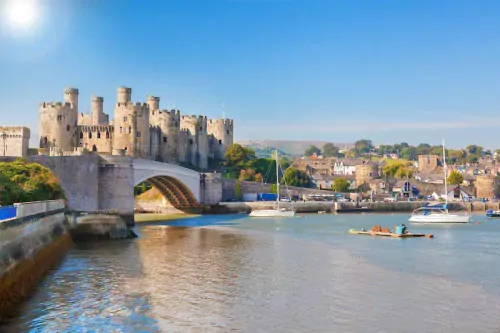
Wales is a country steeped in history and legend, known for its rugged landscapes, ancient castles, and strong sense of identity. Situated on the western side of Great Britain, Wales has a rich and varied history that spans thousands of years, from prehistoric times to the present day.
Prehistoric Wales
The earliest evidence of human activity in Wales dates back to the Paleolithic era, around 230,000 BC. During this time, hunter-gatherer communities roamed the landscape, leaving behind stone tools and other artifacts. The Mesolithic period, which lasted from around 8000 BC to 4000 BC, saw the emergence of more settled communities, who hunted, fished, and farmed the land.
The Neolithic period, which began around 4000 BC, was a time of great change in Wales. It saw the introduction of agriculture, the construction of megalithic monuments like Stonehenge, and the development of more complex social structures. One of the most impressive Neolithic sites in Wales is the burial chamber at Pentre Ifan, which dates back to around 3500 BC.
The Bronze Age, which lasted from around 2500 BC to 800 BC, saw the introduction of metalworking and the construction of more sophisticated burial chambers and standing stones. The Iron Age, which began around 800 BC, was a time of conflict and cultural change, as Celtic tribes from the continent began to settle in Wales.
Roman Wales
In 43 AD, the Roman army invaded Britain, and by 78 AD, they had established a strong presence in Wales. The Roman occupation of Wales lasted for over 300 years and had a profound impact on Welsh culture and society. The Romans built roads, fortifications, and towns throughout Wales, including the fortress at Caerleon and the amphitheater at Caerwent.
The Romans also introduced Christianity to Wales, and by the end of the 4th century, the country had become predominantly Christian. However, after the withdrawal of the Roman army in the early 5th century, Wales fell into a period of political instability and conflict.
Medieval Wales
The medieval period in Wales saw the emergence of powerful Welsh kingdoms, including Gwynedd, Powys, and Deheubarth. These kingdoms were constantly at war with each other, and also with the English, who had begun to exert their influence in Wales.
One of the most famous Welsh rulers of this period was Owain Glyndwr, who led a rebellion against the English in the early 15th century. Glyndwr's rebellion was initially successful, and he was crowned Prince of Wales in 1404. However, his rebellion was ultimately defeated, and Glyndwr went into hiding, becoming a folk hero in Welsh folklore.
The Tudor period, which began in the late 15th century, saw the rise of the Tudor dynasty in England, and the gradual incorporation of Wales into the English state. In 1536, the Laws in Wales Act was passed, which abolished the Welsh legal system and made Wales a part of England.
The medieval period in Wales was a time of great change and upheaval. It saw the emergence of powerful Welsh kingdoms, the arrival of Norman invaders, and the incorporation of Wales into the English state. In this blog post, we will explore the history of medieval Wales, from the 11th to the 15th centuries.
Norman Conquest of Wales
The Norman conquest of England in 1066 had a profound impact on Wales. Norman barons, eager for land and wealth, began to invade Wales in the late 11th century. One of the most famous Norman invaders was William the Conqueror's son-in-law, Robert Fitzhamon, who conquered Glamorgan in 1090.
The Normans introduced new forms of government and administration to Wales, including the castle, which became a symbol of Norman power and domination. They also brought with them the feudal system, which saw Welsh lords pledge their allegiance to Norman barons in exchange for protection and support.
Welsh Kingdoms
Despite the Norman invasion, Wales remained a patchwork of independent kingdoms. The most powerful of these were Gwynedd in the north, Powys in the east, and Deheubarth in the south. These kingdoms were constantly at war with each other, and also with the English, who were expanding their influence in Wales.
One of the most famous Welsh rulers of this period was Llywelyn ap Gruffudd, who ruled Gwynedd from 1258 to 1282. Llywelyn sought to unite the Welsh kingdoms against the English, and was able to secure some significant military victories. However, in 1282, he was defeated by the English king, Edward I, and was killed in battle.
Edward I and the Conquest of Wales
Edward I was determined to conquer Wales and bring it under English control. He began a massive building program, constructing a series of castles and fortifications throughout Wales, including Caernarfon, Conwy, and Harlech.
Edward also introduced the Statute of Rhuddlan in 1284, which established English law and administration in Wales. The statute divided Wales into shires and created the position of the Prince of Wales, which was to be held by the heir to the English throne.
The Welsh Rebellion
Despite Edward's efforts to incorporate Wales into the English state, the Welsh continued to resist English rule. In 1400, a rebellion led by Owain Glyndwr broke out in Wales. Glyndwr, a Welsh nobleman, had been dispossessed of his lands by the English, and he sought to restore Welsh independence.
The rebellion was initially successful, and Glyndwr was able to establish his own government in Wales. He was even crowned Prince of Wales in 1404. However, his rebellion was ultimately defeated, and Glyndwr went into hiding, becoming a folk hero in Welsh folklore.
The Tudor Period
The Tudor period, which began in the late 15th century, saw the rise of the Tudor dynasty in England, and the gradual incorporation of Wales into the English state. In 1536, the Laws in Wales Act was passed, which abolished the Welsh legal system and made Wales a part of England.
The Tudor period also saw a revival of Welsh culture and identity. The Welsh language, which had been in decline for centuries, saw a resurgence, and Welsh literature, music, and art flourished.
Modern Wales
The 19th century saw a revival of Welsh culture and identity, as the country began to industrialize and urbanize. The Welsh language, which had been in decline for centuries, saw a resurgence, and Welsh literature, music, and art flourished.
In the 20th century, Wales played a significant role in the social and political movements of the time. The Welsh miners' strike of 1984-85, for example, was a major industrial action that had a lasting impact on Welsh society and politics.








